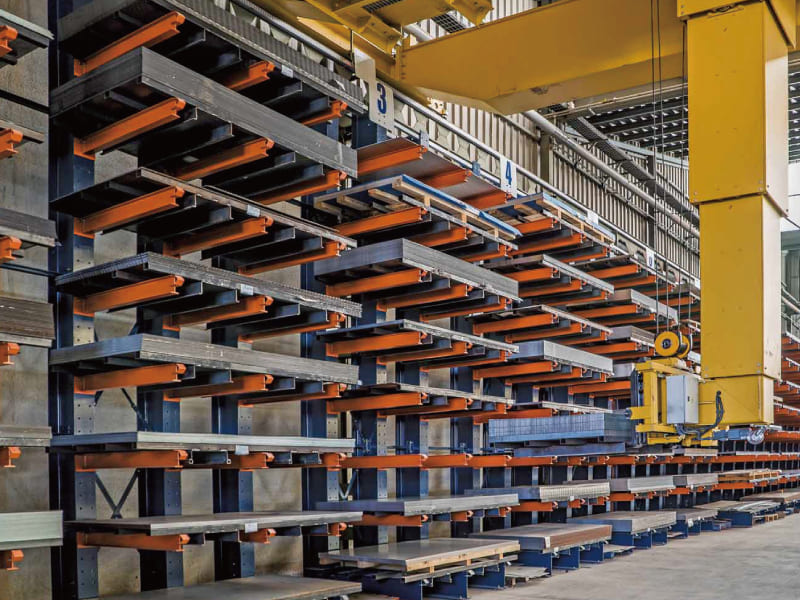Appelez-nous :8615298359310
Appelez-nous :8615298359310
Cantilever racking systems are highly specialized storage structures designed to hold long and bulky items that cannot be easily stored on pallets. Unlike traditional pallet racking systems, which have vertical frames that support horizontal beams, cantilever racks consist of horizontal arms extending from a vertical support column.
These arms act as shelves to store items without being confined by a front column, making it easier to load and unload materials. This flexibility is particularly useful for warehousing long items like lumber, steel, pipes, or furniture.

The basic principle behind cantilever racking is to provide open-front storage for long or bulky items. The absence of front columns means products can be stored along the length of the rack and are supported by the horizontal arms extending from the vertical supports. This allows for easier loading and retrieval using specialized forklifts.
For example, in a warehouse storing lumber or steel pipes, forklifts can approach the rack without the hindrance of vertical front columns, which would otherwise obstruct access in conventional pallet racking systems.
1. Single-Sided Cantilever Racks: Ideal for placing against walls. These racks have arms only on one side of the upright.
2. Double-Sided Cantilever Racks: These provide arms on both sides of the uprights, doubling the storage capacity and making them more efficient for maximizing space in a central location of a warehouse.
Cantilever racking provides a variety of advantages for businesses needing to store non-standard or lengthy items. Here are some key benefits:
The open-front design allows the storage of long or irregularly shaped items that would be difficult to store on traditional pallet racking systems. Cantilever racking is ideal for items like piping, timber, furniture, and steel, which require horizontal storage without being confined by front columns.
The open structure enables easy loading and unloading of materials. Forklift operators can store or retrieve items without maneuvering around upright columns. This improves operational efficiency and reduces handling time.
Cantilever arms can be adjusted to different heights, allowing for a custom configuration that suits the type of inventory stored. This is particularly beneficial for businesses dealing with products of varying lengths or sizes.
Cantilever racking systems are designed to store heavy-duty materials. The I-beam cantilever racks can bear significant loads, making them ideal for industrial use where bulky items are common.
By offering efficient storage for long and bulky items, cantilever racks make the best use of warehouse space. Traditional racking systems would require more floor space or complex handling for such items.
The type of cantilever racking system a warehouse requires depends on the specific storage needs of the business. Here are some common types:
Designed for smaller, lighter items such as tubing or aluminum extrusions. These racks are ideal for businesses that need flexibility but don’t store extremely heavy materials.
Built to store large, heavy items such as steel bars, timber, and bulky furniture. They have a stronger structure with thicker arms and bases to support heavier loads.
I-beam cantilever racks are engineered for industrial settings where extremely heavy materials are stored. They offer high load capacities, thanks to their robust construction using I-beam steel.

When selecting a cantilever racking system for your warehouse, it’s essential to consider various factors to ensure the racks meet your operational needs. Here are some important considerations:
Evaluate the types of products you store. If your warehouse primarily handles long items like lumber or steel pipes, cantilever racking is a perfect solution. For smaller items stored on pallets, pallet racking might be more efficient.
Cantilever racks take up more vertical space than horizontal space. This makes them ideal for high-ceiling warehouses where vertical storage can be maximized.
Not all forklifts are compatible with cantilever racks. You may need specialized equipment like side-loader or multi-directional forklifts for efficient storage and retrieval. Standard front-driving forklifts may require wider aisles, leading to less efficient space utilization.
It’s critical to understand the load-bearing requirements of your inventory. Cantilever racking systems vary in their capacity to hold heavy items, so choosing the right type (light-duty, heavy-duty, or I-beam) is essential for safety and performance.
Cantilever racking systems are widely used in industries that deal with long, bulky, or irregularly shaped items. Below are some common applications:
Cantilever racks are ideal for storing lumber because they provide horizontal storage without confining the length of the items. Heavy-duty cantilever racks can easily hold large quantities of wood.
Manufacturers and suppliers of steel bars, rods, and pipes frequently use cantilever racking due to its ability to store items of various lengths and diameters.
Cantilever racks are often used in furniture warehouses to store large, heavy pieces like sofas, tables, and cabinetry. The open design allows easy handling and access.
Businesses dealing with building materials like drywall, roofing sheets, and siding find cantilever racks an effective storage solution because of their ability to store long, unwieldy products.
Selecting the right cantilever racking system involves more than just identifying the type of items you store. Here’s a step-by-step approach to make the best choice:
1. Evaluate your Inventory: Take a comprehensive look at the types of products you store, their sizes, and their weights.
2. Consult a Professional: Work with a warehouse storage expert to assess your space, layout, and equipment needs.
3. Plan for Future Growth: Select a system that not only meets your current storage requirements but also allows for expansion as your inventory grows.
4. Consider Safety Measures: Ensure your cantilever racking system is installed correctly and maintained regularly to avoid accidents due to overloading or improper handling.
Overcome the efficiency plateau with automated storage and retrieval systems.
Schedule a consultation with Vison for a comprehensive view.
droits d'auteur
© 2024 Jiangsu Vijing Logistics Technology Co., Ltd. Tous les droits sont réservés.
 RÉSEAU PRIS EN CHARGE
RÉSEAU PRIS EN CHARGE